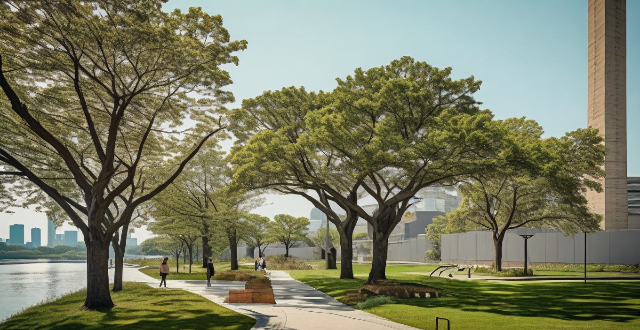The text discusses the importance of tree cover in urban areas for environmental, social, and economic benefits. It highlights the role of trees in improving air quality, regulating climate, managing water, enhancing aesthetic value, building communities, reducing noise pollution, increasing property values, conserving energy, and attracting tourism. The text also suggests ways to promote tree cover in urban areas through planting initiatives, maintenance and protection, and education and awareness campaigns.

The Importance of Tree Cover in Urban Areas
Tree cover plays a crucial role in urban areas, contributing to the overall health and well-being of both the environment and its inhabitants. Here are some key reasons why tree cover is so important:
Environmental Benefits
Improved Air Quality
- Purification: Trees absorb pollutants like carbon monoxide, sulfur dioxide, and nitrogen dioxide from the air.
- Oxygen Production: They produce oxygen through photosynthesis, which helps to reduce the concentration of harmful gases.
Climate Regulation
- Temperature Reduction: Trees provide shade, reducing the heat island effect caused by urban structures.
- Wind Breaks: They can act as natural barriers against strong winds, reducing soil erosion and dust levels.
Water Management
- Rainwater Absorption: Trees absorb rainwater through their leaves and roots, reducing runoff.
- Soil Stabilization: Their root systems help stabilize soil, preventing erosion and flooding.
Social and Health Benefits
Aesthetic Value
- Beautification: Trees enhance the visual appeal of urban landscapes, making them more attractive to residents and visitors.
- Mental Health: Green spaces have been shown to reduce stress levels and improve mental well-being.
Community Building
- Social Interaction: Parks and other green spaces encourage community gatherings and social interactions.
- Educational Opportunities: They provide opportunities for environmental education and awareness among children and adults.
Noise Reduction
- Sound Absorption: Trees can absorb or deflect noise pollution, creating quieter urban environments.
Economic Benefits
Property Value Increase
- Real Estate: Homes surrounded by trees often have higher property values due to increased curb appeal and perceived quality of life.
Energy Conservation
- Shade for Buildings: Trees can provide shade for buildings, reducing the need for air conditioning and lowering energy costs.
Tourism Attraction
- Ecotourism: Urban areas with significant tree cover can attract tourists interested in ecotourism, boosting local economies.
How to Promote Tree Cover in Urban Areas?
Planting Initiatives
- Community Gardens: Encourage community involvement in planting and maintaining green spaces.
- Street Tree Programs: Implement programs that plant trees along streets and public areas.
Maintenance and Protection
- Regular Pruning: Ensure proper maintenance of existing trees to keep them healthy and safe.
- Protective Laws: Establish laws that protect existing trees from being cut down without just cause.
Education and Awareness
- School Programs: Integrate lessons about the importance of trees into school curriculums.
- Public Campaigns: Run campaigns that educate the public on the benefits of tree cover and how they can contribute.
In conclusion, tree cover in urban areas is vital for environmental sustainability, social welfare, and economic growth. By promoting tree planting initiatives, maintaining existing green spaces, and raising awareness about their importance, we can create healthier, happier, and more vibrant urban environments for all.